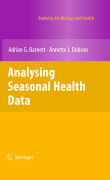
Seasonal patterns have been found in a remarkable range of health conditions,including birth defects, respiratory infections and cardiovascular disease. Accurately estimating the size and timing of seasonal peaks in disease incidence is an aid to understanding the causes and possibly to developing interventions. With global warming increasing the intensity of seasonal weather patterns around the world, a review of the methods for estimating seasonal effects on health is timely. This is the first book on statistical methods for seasonal data written for a health audience. It describes methods for a range of outcomes(including continuous, count and binomial data) and demonstrates appropriate techniques for summarising and modelling these data. It has a practical focus and uses interesting examples to motivate and illustrate the methods. The statistical procedures and example data sets are available in an R package called ‘season’. Description of methods for analysing seasonal data Statistical methods for finding and estimating seasonal patterns are explained With example code for the R statistical software An R package called 'season' can be downloaded via the R home page (http://www.r-project.org/), with example data sets INDICE: Introduction.- Introduction to Seasonality.- Cosinor.- DecomposingTime Series.- Controlling for Season.- Clustered Seasonal Data.- References.-Index.
- ISBN: 978-3-642-10747-4
- Editorial: Springer
- Encuadernacion: Cartoné
- Páginas: 168
- Fecha Publicación: 01/02/2010
- Nº Volúmenes: 1
- Idioma: Inglés
